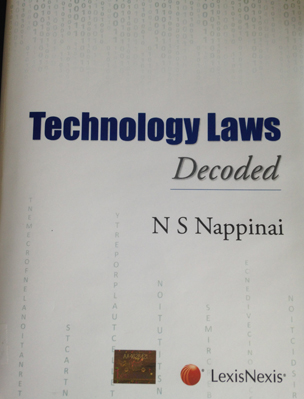BOOK REVIEW
Technology Laws Decoded by N. S. Nappinai
Anirveda Sharma reviews the 1st edition of this book on Technology and Cyber laws in India.
 Technology Laws Decoded by N. S. Nappinai
Technology Laws Decoded by N. S. Nappinai

As the world woke up to the recent WannaCry ransomware attack on computers across the globe, the fault lines in our cyber architecture became evident to citizens across the world. In such times when technology as an insatiable and infinite force has permeated into every aspect of human life there is a growing need to evolve our legal system to meet the needs of this dynamic new interface. With this surrealistic merging of our real world with its virtual counterpart; the fabric of our realities has coalesced beyond the concepts of physical boundaries, sovereignty and ownership. The advent of technology and the internet has irreversibly impacted certain foundational principles of our legal system; so much so that the quick-paced growth of technology stands at absolute odds to the rate of development of legal principles to govern such change.
Recognizing the need for a comprehensive and a cohesive start to our understanding and discussion in the field of technology and cyber laws; the author Ms. N.S. Nappinai endeavors to decode the complexities of technology and address the multitude of legal issues in the field through her book. Being a practicing Advocate with over 25 years of experience in handling matters pertaining to Constitutional, Commercial, Criminal, Technology and Cyber laws alongside her extensive experience in conducting educational and training programmes on Cyber laws for judicial academies and intelligence agencies across the country; the author is uniquely placed to paint a clearer and a more lucid picture of our otherwise complex and convoluted array of technology and cyber laws and regulations.
‘Technology Laws Decoded’ is divided into 7 chapters; each focusing on issues pertaining to the constitution, crimes, IPR, contracts, jurisdiction and electronic evidence. Quoting John Lennon in its introductory lines, the author truly engages the readers’ attention and introduces the reader to the concepts of ‘Cyber’ and ‘Internet’ and our country’s I.T. saga; before delving into the various Constitutional issues connected to technology. The section on ‘Technology and Constitution’ is truly extensive; dealing with the traditional issues of sovereignty, territoriality, privacy and free speech; while also investigating into newer aspects such as surveillance, right to be forgotten, crypto-currencies, cloud computing, Internet-of-Things, robotics, augmented reality and drones. Chapter 2 addresses the interface of ‘Technology and Crime’ by considering issues of cyber security, data protection, confidentiality and cyber-crimes such as cyber-terrorism, hacking, bullying, virus attacks, phishing and tampering. The shifting paradigms of ‘Technology and IPR’ is examined in Chapter 3 with a focus on the various existing IP regimes relating to patents, trademark, copyright, digital rights management and domain name issues. The 4th Chapter i.e. ‘Technology and Contracts’ caters to the exposition of the various facets of e-contracts including contracts by mail, online contracting, trading in virtual assets, digital payments and virtual currencies. An interesting section in this chapter has been dedicated to the legal issues arising from our frequent use of apps or mobile applications including the difficulties of regulating such virtual domains for use by children. Chapter 5 deals with electronic evidence including its various forms and the safeguards in place for its proper appreciation by the Courts of law. The penultimate chapter addresses the issues of jurisdiction in cyberspace pertaining to both civil and criminal disputes; whether within domestic borders or transcending beyond such borders. It further enunciates on the topics of online transactions and consumer courts; anti-suit injunctions and enforceability of foreign judgments in the field. Chapter 7 considers the enforcement of technology laws and the resultant governance of the cyber space; which the Author describes as its Achilles Heel.
Overall, the book provides a bird’s eye view of the wide range of technology and cyber laws in the country; encompassing both the traditional as well as the nascent issues in the field. In the words of the author, the usage of the word ‘technology’ rather than ‘cyber’ in the book’s title represents a conscious decision to expand the perception of its readers in the subject beyond the domain of computing and towards all aspects of technology. In its elucidation, the book draws from laws and cases from multiple jurisdictions to provide a better perspective and expound the direction that the law is currently taking across the world. The book sets the ground work for understanding the existing trends in policies, legislations and cases in this field; coupled with an attempt to highlight the socio-political and socio-legal implications of such decisions in the technological domain. The author has successfully undertaken the gargantuan task of addressing the multitude of issues in this field and the reader or as the author puts it- the victims, would find the clarity and lucidness a welcome change to the otherwise opaque and dry subject of law.
- FIR Copy of Mahatma Gandhi assasination case
- Licito Concurso'20
- Rules for Licito Concurso '20- A National Legislative Drafting Competition
- Registration Form for Licito Concurso-20
- www.apexcourtweekly.substack.com
- www.lawupdater.com/wp/
- XIIIth K.K. Luthra Memorial Moot Court Competition 2017
- President of India Presented with the First Copy of the Book Statement of Indian Law Published by Thomson Reuters





